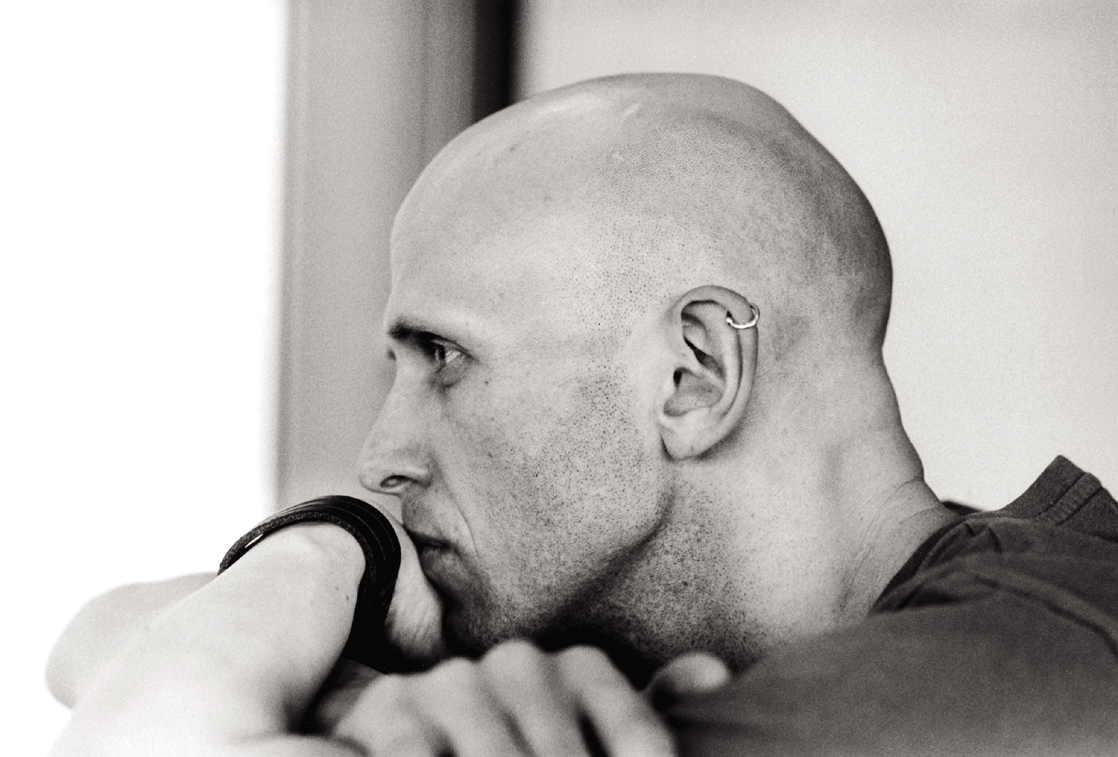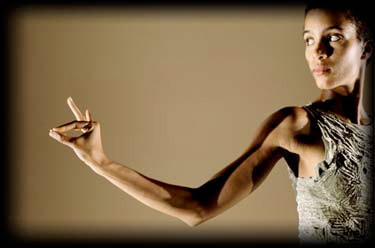Design And Performance Lab
|
Wayne McGregor's Perturbations
Johannes Birringer (c) 2005
Young, successful, very busy and preparing for upcoming trips to Africa and his company's tour of the U.S., Wayne McGregor creates the impression of someone who knows what he wants. A British choreographer of the younger generation emerging in the 1990s (Akram Khan, Michael Clark, Russell Maliphant , Fin Walker), McGregor now enjoys his Random Dance Company's artistic residency at Sadlers' Wells. Awarded in 2002, the residency confirmed the growing recognition of Random's dance style and its pioneering use of new media and technology on stage, and Random is now also celebrated for its educational programs and access to new audiences. While the company tours "AtaXia," their latest creation, the choreographer enjoys an increased demand on working with other established ballet companies, including Rambert, the Royal Ballet, and English National Ballet. He also has time to be involved in the fourth Harry Potter film, finding solutions to questions that plague the digital animators ("how do giants walk?"). In the near future, he will choreograph for the Kirov and NDT1. The Stuttgart Ballet's "Eden / Eden" premiered in April and gave German audiences a taste of McGregor's fast and hyperkinetic choreographic style. I'm not surprised to find out how difficult it is to meet him in person. His production manager tells me McGregor is on jury duty, and ready to go on his Africa trip. Without him being there, I see Random perform "AtaXia" in Nottingham. After the show the dancers quickly depart, too tired or guarded to talk. So I continue the cat and mouse game of phone calls, until the court case is finished. McGregor is relieved, when I ask about the jury duty. "Murder case?" "No. Fraud. It was quite complex, I learnt a lot," he says. "Why Africa?", is my next question. "We are building a studio in Lamu, on the Kenyan coast, it will be a retreat, so that we can have time out to think, and concentrate on what we might be doing, outside of the normal conditions of living." So here's the young London-based choreographer, just returned from his work on "Eden / Eden", ready to embark on a journey to a small tropical island, an idyllic space outside of the speed and complexity of contemporary metropolitan existence. Life within an accelerated world of technologies, computing and telecommunications appears to have shaped his artistic language. If one looks at the evolution of Random, The Millennarium (1997), Sulphur 16 (1998) and Aeon (2000) manifested its emphatic approach to new technology, incorporating animation, digital film, 3D virtual architecture, electronic sound and virtual dancers into the live choreography. More recently, Nemesis (2002) also featured a collaboration with sound artist Scanner. The result was a disturbing mix of film, "covert" sound samples (tracks captured from private mobile-phone conversations) and animatronics to explore the relationship between real and artificial bodies, physical reality and digital distortions. Or were they physical distortions and digital realities? How does he approach dance, to what extent does technology or science inform his aesthetic. "I'm interested in working with concepts of the extended body. And how such concepts work internally -- from within." He tells me the story of his Arts and Science Research Fellowship with the Department of Neuroscience at Cambridge University. The collaboration with dance researcher Scott deLahunta and the neuroscientists became known as the "Choreography and Cognition" project (www.choreocog.net). In a first phase, McGregor went to the labs where neuroscientists normally observe the "movement of the brain/mind" under controlled conditions. "But it's hard to dance with electrodes attached to the head," I suggest. "Yes, this phase was really more about finding alternative modes of looking, analysis and questioning through the eyes of the scientists. Later in 2003, when the cognitive scientists and experimental psychologists came to my rehearsal studio, we tried to explore the interface between mind and body in a non-verbal manner. I asked myself whether we could collaborate without words. We looked for synergies in our ways of thinking about creativity and cognition, movement control and coordination." "But are there parallel interests," I ask, "or do the scientists observe different things?" McGregor's mind works fast, his answers are highly articulate and he enjoys the interest that the so-called hard sciences have recently shown the performing arts. "There may be different frames of reference, in clinical and experimental psychology or in a dance studio, but we share a common interest in how the brain carries out movement, how digital systems show data from neurological processes, how we experience the relations between imagined and real movement." McGregor is excited now. "Of course, as highly trained dancers we tend not to think of the non-virtuosic, or the break-downs, in the way a neuropsychologist may work with deficits or traumata. In clinical contexts the scientists collect data that help to deal with sensorimotor or cognitive deficits. But there are overlaps, in the way in which we explore mental spaces or look at reactive and predictive control of movement. In dance we need practical information to move, to exercise our kinaesthetic intelligence, our excess of kinetic potential." Now I become curious, as I imagine McGregor and his dancers going through their rehearsal processes being watched silently by neuroscientists. Those processes are familiar to an increasing number of dancers and children in Europe attending his workshops or benefiting from Random's much-praised educational outreach program "System R" (aimed at young people in school and community projects). In 2001 McGregor participated in the "Tanz und Neue Medien" workshops at the Choreographische Zentrum NRW, where he taught working with animation and telematics as techniques to "extend the body." The workshop students were given small tasks to solve, a method of generating movement material that is quite common. What irritated the students in Essen was McGregor pushing them to use physical and digital images for movement which undermined their familiar body images. He enjoys finding forms in which the live body on a real stage behaves as if it were virtual or unnatural. Is it a matter of what problems one asks the dancers to solve? "How did 'AtaXia' emerge from working with the scientists?", I inquire, noticing that in the "Choreography and Cognition" project McGregor responded to the neuroscientists' interest in the disturbance of normal patterns of perception and motion control. "Yes, rehearsing 'AtaXia' focused on the dis-organization of the body, discoordination, and loss of control. It was strange, we had started to work with this notion of 'loss' when one day a woman walked into our studio who suffers from ataxia, a brain condition which causes severe loss of coordination, and she told us how she experiences this condition. For example, there are times when she cannot remember how to walk down a staircase, but she told us incredibly vivid images that she dreams about movement. Her condition also relates to how older people may not be able to walk anymore without help." In the rehearsals, McGregor began to introduce "perturbations" -- disruptions and interferences into movement coordination -- which became the creative strategy for the choreographic design of "AtaXia." The dancers were given conflicting instructions or dual tasks; they performed with eyes closed or using different parts of their body with different speeds. Playing tricks with mind and memory. I tell McGregor that I found it hard to watch the performance in Nottingham. For once, the excessively loud and pounding minimalist music score by Michael Gordon drove me nearly insane, it kept me on edge all the time and made it hard to concentrate. McGregor laughs, "well, of course we try to enhance the ambivalence or sensory confusion our audience feels when watching the piece. Body and senses are an integral part of understanding the world, but how do you perceive when the information in the brain is scrambled?"
Harsh neon lighting, randomly programmed and constantly changing, creates a nervous environment. "AtaXia" is not easy to watch: the extraordinary dancers, whose technical capabilities remind me of Forsythe's former Frankfurt Ballet, show such precisely articulate control of movement in the opening solos that it comes as a shock -- registered as a slow awakening in my drowned-out inner ears -- to see them gradually flailing, needing to rely on the support from other dancers, as they slink down to the floor, tumble out of control. A film screen descends, half-way through the piece, and an extremely fast sequence of distorted abstract images and sentence-fragments flies by, as if the brain's synapses were firing aimlessly and furiously. The film is like an homage to Kubrick's Space Odyssey, the brain shooting into a black hole while our heads are twitching. In the third part of the dance, perspex sheets are lowered: now the dancers are behind surfaces that further distort their bodies and movement. "AtaXia" blurs, and our consciousness cannot recover from it. "At this point," McGregor suggests when I tell him how the work left me emotionally detached," you may experience the complete depletion of attention in the body. We use the sound and the doubling of distorted body images to aggressively affect your ability to watch in a particular way." But, I protest, is this not a highly technical formalism that keeps me disengaged? McGregor believes it's the opposite, his perturbations are visceral and cut to the bones, since there is no harmony (between movement and music) but I am watching a multiplicit choreography against the turbulences of the visual and acoustic environment. I suffer depletion, quite literally. Where to go from here? "In my next piece," he confides, "I will take information from the heart, I want to work with heart specialists. 'AtaXia' already taught us what it means not to be able to walk. What happens if you imagine your heart stops? What are the emotional consequences of neuobiological malfunctions, how is perception altered, how does the breakdown of cognition cause depression?" McGregor's questions are now becoming as specific as they are unanswerable: "What happens in the brain when you move your finger? Such a process of thinking questions also affects how you think dance."
I wonder how he understands his work in comparison to Konzepttanz on the continent. "My concepts are always behind the dance," he replies, I think I'm not like Jérôme Bel, Xavier Le Roy, and others who expose the performance machine itself. I guess my solutions are different, as I work primarily with extreme physical language. What matters to me is an ethics of the body, and the questions we ask: What is the relationship to body? What is the body? Who owns it? How are we connected? In 'Eden / Eden' I wanted to explore how we can be responsible in a conversation about cloning, biogenetics, and biopolitics. We used Steve Reich's music for 'Dolly,' and the score is full of conversations without answers." Let us have debate, I agree, beginning to sense McGregor's urgency - contemporary dance is a cultural forum, it extends beyond its field, using a highly articulate physical-digital language which understands its social and technological conditions as an integral part of artistic work. And, McGregor adds, "the body itself has much to say with physical forms and designs. What counts is that we are responsible in public conversation, so that there is a range, a wide diversity of opinions." He knows I am going to ask about Lamu now. Why Africa? "Well, in order to reflect, it's important to change the geography of thinking, to empty your head of your normal habits, to be in a place without roads."
Summary (in german)
Aus der jungen Garde der exzentrischen Britart Choreografen (Akram Khan, Michael Clark, Russell Maliphant , Fin Walker, Jonathan Burrows) ragt er heraus: Wayne McGregor, neoklassischer Digitalexperimenteur, Springteufel, virtueller Gehirnspezialist. Der Körper als Insekt - das tanzte er schon lange bevor Xavier Le Roy es uns mühselig in Lecture Performances erklären wollte. Seine Random Dance Company etabliert sich seit 2002 am Sadler's Wells Theatre (London), nach einer Reihe von Stücken -- The Millennarium , Sulphur 16, Aeon und Nemesis - die vor allem ein jüngeres Publikum begeisterten. Zuletzt war AtaXia auf Tournee, enstanden aus Proben nach gemeinsamer Forschungsarbeit mit Neurowissenschaftlern und Psychologen. Der Choreograf trifft nicht zum Interview-Termin in Nottingham ein; er sitzt auf der Geschworenenbank in London, und aus der Verantwortung stiehlt man sich nicht. Seine Bemerkungen zu Tanz, Gehirnforschung, Technologien, Erinnerungsverlust und Körper-Verfremdungen laufen auf den Begriff "perturbations" (Verstörungen) hinaus. In den Proben zu AtaXia wurden den Tänzern widersprüchliche Aufgaben gestellt, die mentale und motorische Prozesse aus der Fassung warfen - der Tanz verliert die Kontrolle über sich. Aber wer, fragt McGregor, ist dieses "sich" - und wer kontrolliert die Körper heute? Was ist menschliches Leben? Mit welcher Ethik des Körperseins und der Beziehungen des Menschlichen zur genetischen Transformationsarbeit der Biopolitik und der Ökonomie beschäftigt sich zeitgenössische Tanzkunst? Random Dance versuche, sich mit den Fragen hinter ihren Tanzwerken (vor kurzem: Eden / Eden am Stuttgarter Ballett) in eine öffentliche Debatte einzubringen. Der Choreograf aber ist schon auf dem Weg nach Lamu (Kenia), um dort ein Studio ausserhalb der gewohnten Parameter aufzubauen. Die Fragen zu den "Verstörungen" stellt Johannes Birringer.
Johannes Birringer directs the Interaktionslabor Göttelborn (http://interaktionslabor.de). He is co-editor of "Tanz im Kopf/Dance and Cognition", GTF Jahrbuch 15, 2005.
Wayne McGregor. Photo (c) Nick Mead. Other photos: (c) Ravi Deepres
|


